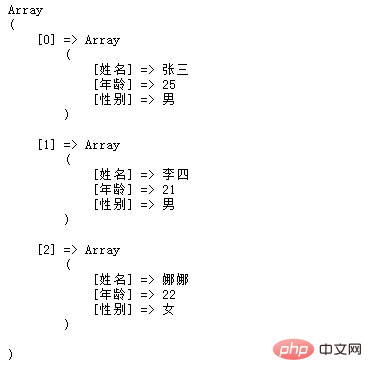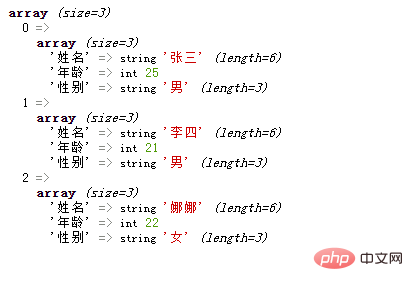 Backend Development
Backend Development
 PHP Tutorial
PHP Tutorial
 PHP array learning talks about several methods of outputting arrays
PHP array learning talks about several methods of outputting arrays
PHP array learning talks about several methods of outputting arrays
In the previous articles "How to create and initialize a one-dimensional array in PHP array learning (detailed code explanation)" and "A brief analysis of the creation method of a two-dimensional array in PHP array learning" In this article, we introduce the definition method of one-dimensional array and two-dimensional array through code examples, which is simple and easy to understand.
Now that the array is created and initialized, after performing some operations, it needs to output and print out the operation results. So how to output PHP array? The following article will introduce to you several methods of array output: print_r(), var_dump(), echo/print. (Attachment: PHP function array array function video explanation)
1. Use print_r() to output the array
The print_r() function is used to print variables in a more understandable form. The print_r() function can output the contents and structure of the entire array, and the keys and elements will be displayed in a certain format.
<?php
header("Content-type:text/html;charset=utf-8");
$array = array
(
array("姓名"=>"张三","年龄"=>25,"性别"=>"男"),
array("姓名"=>"李四","年龄"=>21,"性别"=>"男"),
array("姓名"=>"娜娜","年龄"=>22,"性别"=>"女")
);
print_r($array);
?>Output result:
Array ( [0] => Array ( [姓名] => 张三 [年龄] => 25 [性别] => 男 ) [1] => Array ( [姓名] => 李四 [年龄] => 21 [性别] => 男 ) [2] => Array ( [姓名] => 娜娜 [年龄] => 22 [性别] => 女 ) )
Do you feel that the output result is too long and you do not use reading. You can add a piece of code "echo '
';" before the print_r() output statement: </p><pre class='brush:php;toolbar:false;'><?php
header("Content-type:text/html;charset=utf-8");
$array = array
(
array("姓名"=>"张三","年龄"=>25,"性别"=>"男"),
array("姓名"=>"李四","年龄"=>21,"性别"=>"男"),
array("姓名"=>"娜娜","年龄"=>22,"性别"=>"女")
);
echo '<pre class="brush:php;toolbar:false">';
print_r($array);
?>The output result is more conducive to reading, the output result:

2. Use var_dump() to output the array
Similar to the print_r() function, the var_dump() function can also dump the entire array Data content and structure are output. However, var_dump() is more powerful than print_r(). It can print multiple variables at the same time and give the type information of the variables.
The var_dump() function can output relevant information (type and value) of variables. When outputting an array, the array will recursively expand the values and display its structure through indentation.
<?php
header("Content-type:text/html;charset=utf-8");
$array = array
(
array("姓名"=>"张三","年龄"=>25,"性别"=>"男"),
array("姓名"=>"李四","年龄"=>21,"性别"=>"男"),
array("姓名"=>"娜娜","年龄"=>22,"性别"=>"女")
);
var_dump($array);
?>Output result:

Description:
print_r() and var_dump() functions are generally used for debugging programs, more In many cases, echo is used to output specific array unit values.
3. Use echo/print to output an array
echo() is used to output one or more strings.
Strictly speaking, echo is not a function, it is actually a language structure; therefore, it is not necessary to use parentheses to indicate parameters, single quotes or double quotes can also be used.
However, if you pass more than one argument to echo(), you cannot use parentheses because a parsing error will be generated.
print() and echo() are somewhat similar (it is actually a language construct), but the difference is that echo can accept multiple parameters and has no return value, while print() can only Accepts one parameter and returns a value.
When using echo/print for array output, only a certain element in an array can be output. Let's take a closer look through code examples:
<?php
header("Content-type:text/html;charset=utf-8");
$array= array("香蕉","苹果","梨子","橙子","橘子","榴莲");
//输出语句
echo '$array[0] = '.$array[0].'<br>';
echo '$array[1] = '.$array[1].'<br>';
echo '$array[2] = '.$array[2].'<br>';
print '$array[3] = '.$array[3].'<br>';
print '$array[4] = '.$array[4].'<br>';
print '$array[5] = '.$array[5].'<br>';
?>Output:
$array[0] = 香蕉 $array[1] = 苹果 $array[2] = 梨子 $array[3] = 橙子 $array[4] = 橘子 $array[5] = 榴莲
Statements in the form of "$array variable name[subscript]" are used to access arrays of elements to determine the elements that need to be output. For example, in the above example, "$array[0]" is to access the first element in the array (the subscript of the index array starts from zero), so "echo $array[0 ]" statement can output "banana".
If you want to output all the elements in the array, you need to use a loop statement to traverse the array and output the elements in the array one by one.
Let’s take the foreach statement as an example to see in detail how to loop through the array and output all the elements in the array: (Video tutorial attached: foreach loop)
<?php
header("Content-type:text/html;charset=utf-8");
$array= array("香蕉","苹果","梨子","橙子","橘子","榴莲");
foreach ($array as $val){ // 遍历数组
//输出数组元素
echo $val."<br>";
}
?>Output results:
香蕉 苹果 梨子 橙子 橘子 榴莲
Recommendation: 《2021 PHP interview questions summary (collection)》《php video tutorial》
The above is the detailed content of PHP array learning talks about several methods of outputting arrays. For more information, please follow other related articles on the PHP Chinese website!

Hot AI Tools

Undresser.AI Undress
AI-powered app for creating realistic nude photos

AI Clothes Remover
Online AI tool for removing clothes from photos.

Undress AI Tool
Undress images for free

Clothoff.io
AI clothes remover

Video Face Swap
Swap faces in any video effortlessly with our completely free AI face swap tool!

Hot Article

Hot Tools

Notepad++7.3.1
Easy-to-use and free code editor

SublimeText3 Chinese version
Chinese version, very easy to use

Zend Studio 13.0.1
Powerful PHP integrated development environment

Dreamweaver CS6
Visual web development tools

SublimeText3 Mac version
God-level code editing software (SublimeText3)

Hot Topics
 1664
1664
 14
14
 1423
1423
 52
52
 1317
1317
 25
25
 1268
1268
 29
29
 1246
1246
 24
24
 Explain JSON Web Tokens (JWT) and their use case in PHP APIs.
Apr 05, 2025 am 12:04 AM
Explain JSON Web Tokens (JWT) and their use case in PHP APIs.
Apr 05, 2025 am 12:04 AM
JWT is an open standard based on JSON, used to securely transmit information between parties, mainly for identity authentication and information exchange. 1. JWT consists of three parts: Header, Payload and Signature. 2. The working principle of JWT includes three steps: generating JWT, verifying JWT and parsing Payload. 3. When using JWT for authentication in PHP, JWT can be generated and verified, and user role and permission information can be included in advanced usage. 4. Common errors include signature verification failure, token expiration, and payload oversized. Debugging skills include using debugging tools and logging. 5. Performance optimization and best practices include using appropriate signature algorithms, setting validity periods reasonably,
 PHP and Python: Comparing Two Popular Programming Languages
Apr 14, 2025 am 12:13 AM
PHP and Python: Comparing Two Popular Programming Languages
Apr 14, 2025 am 12:13 AM
PHP and Python each have their own advantages, and choose according to project requirements. 1.PHP is suitable for web development, especially for rapid development and maintenance of websites. 2. Python is suitable for data science, machine learning and artificial intelligence, with concise syntax and suitable for beginners.
 PHP in Action: Real-World Examples and Applications
Apr 14, 2025 am 12:19 AM
PHP in Action: Real-World Examples and Applications
Apr 14, 2025 am 12:19 AM
PHP is widely used in e-commerce, content management systems and API development. 1) E-commerce: used for shopping cart function and payment processing. 2) Content management system: used for dynamic content generation and user management. 3) API development: used for RESTful API development and API security. Through performance optimization and best practices, the efficiency and maintainability of PHP applications are improved.
 PHP: A Key Language for Web Development
Apr 13, 2025 am 12:08 AM
PHP: A Key Language for Web Development
Apr 13, 2025 am 12:08 AM
PHP is a scripting language widely used on the server side, especially suitable for web development. 1.PHP can embed HTML, process HTTP requests and responses, and supports a variety of databases. 2.PHP is used to generate dynamic web content, process form data, access databases, etc., with strong community support and open source resources. 3. PHP is an interpreted language, and the execution process includes lexical analysis, grammatical analysis, compilation and execution. 4.PHP can be combined with MySQL for advanced applications such as user registration systems. 5. When debugging PHP, you can use functions such as error_reporting() and var_dump(). 6. Optimize PHP code to use caching mechanisms, optimize database queries and use built-in functions. 7
 The Enduring Relevance of PHP: Is It Still Alive?
Apr 14, 2025 am 12:12 AM
The Enduring Relevance of PHP: Is It Still Alive?
Apr 14, 2025 am 12:12 AM
PHP is still dynamic and still occupies an important position in the field of modern programming. 1) PHP's simplicity and powerful community support make it widely used in web development; 2) Its flexibility and stability make it outstanding in handling web forms, database operations and file processing; 3) PHP is constantly evolving and optimizing, suitable for beginners and experienced developers.
 Explain the match expression (PHP 8 ) and how it differs from switch.
Apr 06, 2025 am 12:03 AM
Explain the match expression (PHP 8 ) and how it differs from switch.
Apr 06, 2025 am 12:03 AM
In PHP8, match expressions are a new control structure that returns different results based on the value of the expression. 1) It is similar to a switch statement, but returns a value instead of an execution statement block. 2) The match expression is strictly compared (===), which improves security. 3) It avoids possible break omissions in switch statements and enhances the simplicity and readability of the code.
 PHP vs. Python: Understanding the Differences
Apr 11, 2025 am 12:15 AM
PHP vs. Python: Understanding the Differences
Apr 11, 2025 am 12:15 AM
PHP and Python each have their own advantages, and the choice should be based on project requirements. 1.PHP is suitable for web development, with simple syntax and high execution efficiency. 2. Python is suitable for data science and machine learning, with concise syntax and rich libraries.
 PHP and Python: Code Examples and Comparison
Apr 15, 2025 am 12:07 AM
PHP and Python: Code Examples and Comparison
Apr 15, 2025 am 12:07 AM
PHP and Python have their own advantages and disadvantages, and the choice depends on project needs and personal preferences. 1.PHP is suitable for rapid development and maintenance of large-scale web applications. 2. Python dominates the field of data science and machine learning.



